is red meat good for diabetics Tips on maintaining a low-purine diet for gout
Gout is a painful form of arthritis that occurs when uric acid levels in the blood become too high. This condition can cause severe joint pain and inflammation, making it important for individuals with gout to follow a low-purine diet. By reducing the intake of foods high in purines, people with gout can help manage their symptoms and prevent future flare-ups.
Understanding a Low-Purine Diet
A low-purine diet aims to limit the consumption of foods that are rich in purines. Purines are natural compounds found in certain foods and beverages. When purines are broken down by the body, they produce uric acid. Therefore, reducing the intake of purine-rich foods can help control uric acid levels and alleviate the symptoms of gout.
 Some examples of high-purine foods that should be limited or avoided include organ meats such as liver and kidneys, shellfish, red meat, and certain types of fish such as anchovies and sardines. Alcohol, particularly beer, is also known to increase uric acid levels and should be consumed in moderation or avoided altogether.
Some examples of high-purine foods that should be limited or avoided include organ meats such as liver and kidneys, shellfish, red meat, and certain types of fish such as anchovies and sardines. Alcohol, particularly beer, is also known to increase uric acid levels and should be consumed in moderation or avoided altogether.
On the other hand, a low-purine diet encourages the consumption of foods that are low in purines. This includes most fruits and vegetables, whole grains, low-fat dairy products, and plant-based protein sources such as tofu and legumes. It is important for individuals following a low-purine diet to stay hydrated by drinking plenty of water throughout the day.
The Benefits of a Low-Purine Diet
Adhering to a low-purine diet can provide numerous benefits for individuals with gout. By reducing the intake of purine-rich foods, it is possible to decrease the production of uric acid in the body, leading to lower uric acid levels in the blood.
 Studies have shown that following a low-purine diet can help prevent gout attacks and reduce the severity of symptoms in individuals already diagnosed with gout. By managing uric acid levels, this dietary approach can also minimize the risk of urate crystal formation in the joints, which is a leading cause of the intense pain experienced by gout sufferers.
Studies have shown that following a low-purine diet can help prevent gout attacks and reduce the severity of symptoms in individuals already diagnosed with gout. By managing uric acid levels, this dietary approach can also minimize the risk of urate crystal formation in the joints, which is a leading cause of the intense pain experienced by gout sufferers.
In addition to alleviating gout symptoms, a low-purine diet may have other positive effects on overall health. By promoting the consumption of fruits, vegetables, and whole grains, this diet can provide essential nutrients and fiber, supporting cardiovascular health and helping to maintain a healthy weight. Furthermore, by limiting the intake of alcohol and highly processed foods, individuals can improve their overall dietary quality and reduce the risk of other chronic diseases such as heart disease and diabetes.
Incorporating a Low-Purine Diet into Your Lifestyle
Although following a low-purine diet may require some adjustments to your current eating habits, making gradual changes and seeking guidance from a registered dietitian can make the transition easier and more manageable. Start by familiarizing yourself with the purine content of common foods and plan your meals accordingly.
When creating your low-purine meal plan, aim for a variety of nutrient-dense foods that are low in purines. Include a wide range of fruits and vegetables, whole grains, and healthy sources of protein such as lean meats, poultry, and fish. Be sure to stay well-hydrated by drinking at least eight cups of water per day.
Remember, while a low-purine diet can be beneficial for individuals with gout, it is important to consult with a healthcare professional before making significant changes to your diet. They can provide personalized advice based on your specific health needs and help you create a plan that is both effective and sustainable.
By incorporating a low-purine diet into your lifestyle, you can take a proactive approach to manage your gout symptoms and improve your overall health. Stay committed to making healthy choices and seek support from healthcare professionals or support groups if needed. With time and perseverance, you can experience the benefits of a low-purine diet and live a more comfortable life with gout.
If you are looking for What You Need to Know About Red Meat and Diabetes you’ve came to the right web. We have 5 Images about What You Need to Know About Red Meat and Diabetes like Tips on Maintaining a Low-Purine Diet for Gout - Facty Health, What You Need to Know About Red Meat and Diabetes and also Red Meat: What is it good for? — NephJC. Here you go:
What You Need To Know About Red Meat And Diabetes
 news.yahoo.cominflammation pcos meat
news.yahoo.cominflammation pcos meat
Is Red Meat Good Or Bad? - YouTube | Red Meat, Grass Fed Meat, Red Meat Bad
 www.pinterest.comTips On Maintaining A Low-Purine Diet For Gout - Facty Health
www.pinterest.comTips On Maintaining A Low-Purine Diet For Gout - Facty Health
 facty.compurine gout maintaining
facty.compurine gout maintaining
Red Meat: What Is It Good For? — NephJC
 www.nephjc.comadelgazar proteínas
www.nephjc.comadelgazar proteínas
Red Meat: Good Or Bad For Health?
 www.medicalnewstoday.comRed meat: good or bad for health?. Is red meat good or bad?. What you need to know about red meat and diabetes
www.medicalnewstoday.comRed meat: good or bad for health?. Is red meat good or bad?. What you need to know about red meat and diabetes